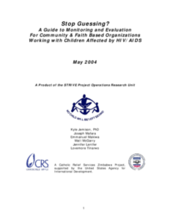The HIV/AIDS pandemic is unprecedented in the enormity of its impact on children, family structures, and communities. The United States Agency for International Development (USAID) estimates that by 2000, 13.1 million children under the age of fifteen had lost one or both parents to AIDS, just in sub-Saharan Africa. If current trends continue, the number of orphans in sub-Saharan Africa could reach 14.9 million by the year 2010. As staggering as these numbers are, they pale in comparison to the looming global catastrophe that will result if HIV/AIDS continues its unchecked expansion into Southeast Asia, the Caribbean, India, Eastern Europe, and Russia.
An examination of current HIV/AIDS programs indicates that while experiences are being shared; it is in an unsystematic manner. Information varies in both content and in method of generation, making it extremely difficult to compare programs and different interventions. Consequently, best practices are difficult to identify and evidence of project impact tends to be weak or non-existent. Thus, there is an urgent need to verify that the diverse interventions targeted at orphans and vulnerable children are efficient, effective, and worth scaling up or replicating. The only way to make these determinations is by carrying out Monitoring and Evaluation and Operations Research.
This manual was developed as a response to this problem and to assist organizations in establishing their own M&E and OR structures. Its purpose is to share practical ideas and techniques that will help organizations to set up and manage effective M&E and OR methods and systems. It defines M & E and OR, explains the relationship between M&E and OR and how to incorporate M&E and OR considerations into the design of goals, objectives, and indicators. The manual also addresses how to establish a Monitoring Plan; monitoring and measuring performance for specific interventions targeted at children; different strategies, approaches, tools and instruments; and issues that are unique to interventions for children.
The manual would be useful to directors, program managers, field officers, implementing partners, etc.
©Catholic Relief Services and U.S. Agency for International Development

